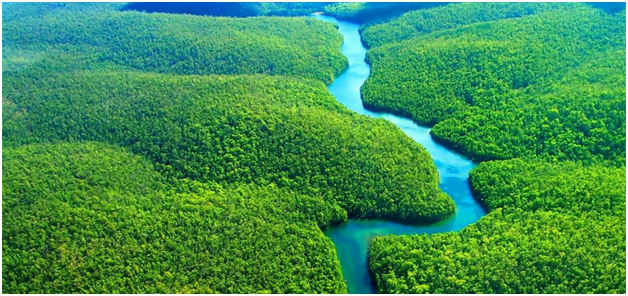One article is not enough for this topic. We all know that a lot of you guys turn their eyes wide when they read topics such as this. We try to picture what it is like to be in the Amazon Rainforest. This two-part article focuses mainly on what the place has to offer. But hey, aside from literally being in the forest, there is no better way than to read this and have your imaginations work for you.
The Amazon rainforest is a habitat to several numbers of species that composes twenty (20) percent of those found on planet earth. With an area of two and a half million square miles, which basically represents almost seventy (70) percent of South America, The Amazon Rainforest broadens and traverses into nine countries namely: Colombia, Brazil, Ecuador, Peru, Guiana, Suriname, Venezuela and French Guiana.
Verily, the Amazon rainforest is being regarded to be the globe’s biggest natural resource, constitutes more than fifty (50) percent of the Earth’s entire rainforests. Regarded as the Earth’s lungs, it basically produces more than twenty (20) percent of the Earth’s oxygen; more than any other sole source having said that, the Amazon Rainforest is a crucial source of the air that we now breathe.
It’s canopies are habitat to tie world renowned Toucan with its thick, large colorful beak and short neck in fusion of blue, white, red and blue. Further, the Amazon Rainforest caters over thirty three (33) percent of the total bird species that can be found on Earth. A lot of which are considered to be endangered species because of man’s encroachment as well as the deforestation of the rainforest.
Further to its plentiful and copious avian population, the Amazon Rainforest is regarded as home to the capybara. Weighing at about a hundred pounds and at about two feet in height, the capybara is considered to be the world’s biggest rodent. Regarded as an endangered species, it is an efficient swimmer. It spends most of its existence underwater. The capybara mainly exists on a diet of melons, grass, squash, and water vegetation.
The Amazon Rainforest’s biggest mammal is not a land animal, as you might assume, but exists in the Amazon River as well as its tributaries, the Amazonian Manatee. It is more commonly known as sea cows because of its herbivorous attitude and spending most of its days grazing. Some are also contending that they saw mermaids when encountering the Amazonian manatee.
Recognized as one of the prettiest of all the Amazon Rainforest’s creatures, is the mythical Amazon pink river dolphin that is suffering from the effects of development. The Amazon pink river dolphin is an extreme endangered species because of the pollution of its habitat from mining and agriculture industry. Local fisher folks do not witness the dolphin for its beauty because of its discipline of tearing holes in their nets to steal their catch.
The second part of this article discusses the different predators that roam around the wildlife of the Amazon Rainforest.
Meanwhile, the Jaguar is considered as beautiful but deadly Amazon Rainforest settler. An efficient hunter and an excellent athlete/runner, the jaguar grows up to seven feet long and can weigh in as much as two hundred fifty pounds. The jaguar is naturally adept on water or land and can climb trees and run while hunting its prey in no time. They swim after aquatic prey like the turtles or pirarucu.
On the other hand, one of the largest predators in the Amazon rainforest is the resident black caiman. It is less attractive and as equally dangerous as the jaguar. With no natural foes, other than man, it can grow to as huge as twenty feet in length and can weigh in as much as four thousand pounds. It has been known to eat creatures like capybara, rover otters and even humans.
And without all people knowing, with its broad animal population, the Amazon Rainforests is home not only to huge predators but is also a habitat for small and microscopic creatures. One of the deadliest small creatures is the poison arrow frog. Harmless if left alone it has the most powerful poison that is known to man. Its toxin poison can kill as much as one hundred and fifty people. The Amazon Indians have long harvested the frog because of its poison, which they utilize on the tips of their arrows when hunting.
The Amazon Rainforest is a healthy habitat for the fabled and dangerous anaconda, which grows its entire existence. The biggest ever caught was about thirty feet long with the girth of forty five inches and is assumed to approximately weigh five hundred pounds.
The most infamous of all the wildlife in Amazon Rainforest is undoubtedly the piranha. The best known and most feared of all the creatures in the Amazon is the red bellied piranha. Feeding in huge schools they can converge upon, and munch with their razor sharp teeth, such pres as jaguars, anacondas, and caimans. However, contrary to famous beliefs, attacks on humans never occurred.
Hundreds of species of wood are also prevalent in this area. Some are endangered while others are being utilized by the locals mainly for construction of houses and barns and other settling structures. However, abusive people are starting to cut trees for commercial purposes. We have to do something in order for us to sustain the habitat and we should not let this dissipate. Let us prevent these illegal loggings so that not only the beauty but also the abundance of the rainforest can be preserved and maintained to the highest and optimum productivity.
At the end of the day, you cannot do anything but to appreciate nature’s blessing that people can avail of. Truly indeed, the Amazon Rainforest has a lot of things to offer, from the plant species, to animals and even wood!


